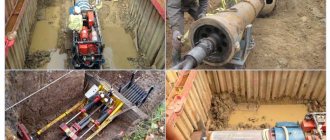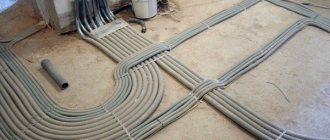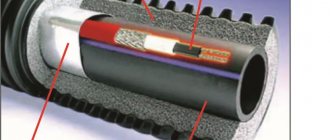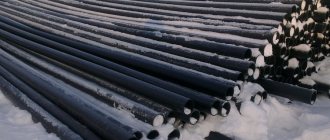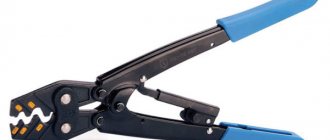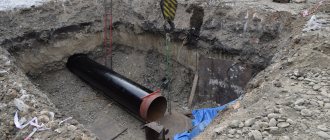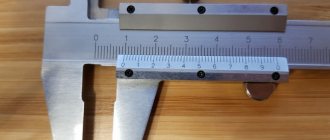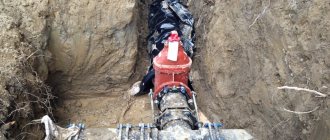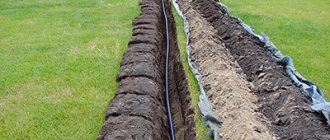It states that for open and closed wiring, wires and cables sheathed in combustible materials must be protected with pipes and ducts. In addition, laying corrugated pipe may be required in the following cases:
- For laying wiring on flammable surfaces, such as wood or plastic.
- For laying wiring in concrete pouring.
- For installation of external networks on the façade of a building or over the air.
- For installing cables underground.
- For ease of dismantling and repair of cable networks in the future. If the wire is hidden in a corrugation that has a broach, then it will be easier to pull it out later without destroying the plaster.
Please note that the PUE does not oblige the use of corrugation - you can also use a cast pipe. However, corrugated pipe is more convenient to install, since it is easier for it to go through corners, it is lighter in weight and more flexible.
Cable corrugation, sizes, prices
Corrugated pipes for electrical networks are available in sizes from 16 mm to 65 mm. When choosing a size, you need to take into account that these products have two diameters - outer and inner. If you are going to lay several conductors - wires or cables - the diameter must be selected so that there is a clearance of at least half the radius. This requirement is based on the fact that when installed in groups (it is necessary, by the way, to take a special cable), it will heat up more and the presence of an air gap will contribute to better heat dissipation.
The price of corrugated electrical pipes depends on many factors
Size selection
The choice of corrugation diameter also depends on the area where it will be laid:
- for lighting fixtures - 16 mm;
- to sockets and switches - at least 20 mm;
- from the main distribution box to the next box, from the shield - at least 25 mm;
- the connection between two electrical panels is at least 32 mm, and it is better to have a spare second line;
- passage through the floors with rigid corrugation of at least 40 mm in diameter;
- laying low-current cables (telephone, internet, antenna, etc.) - from 25 mm.
The diameter of the corrugation for laying the cable is selected depending on the number and cross-section of wires. Data for copper conductors are given in the table.
Table for choosing the diameter of the corrugation for cables and wires depending on the cross-section and number of wires
This information is for reference only, but you can use it as a guide. You can take a larger, but not smaller diameter.
Prices
Generally speaking, the cheapest is PVC cable corrugation, in the middle range - PP and HDPE, and the most expensive is metal corrugation. Moreover, the option with broaching is slightly more expensive than without it
When purchasing, you need to pay attention to the same wall thickness and color uniformity
Different materials, colors, wall thicknesses and different prices
Corrugated cables are sold in coils of 50 and 100 meters, less often you can find them in meters, but the price is then a little higher. In general, the price depends not only on the material, but also on the wall thickness. The cheapest is lightweight PVC corrugated cable, but sometimes it looks more like just a film. It’s hard to say what this can protect against. If you care about quality, it is better to purchase everything related to electrical equipment not in construction supermarkets like Leroy, etc. and in specialized ones. The quality there is usually better, and the prices, if higher, are reasonable. To give you an idea of the possible price range, we will summarize several types of corrugation with brief technical characteristics in the table.
| Name | Type | External diameter | Inner diameter | Broach | Price per meter | IP | Purpose |
| PVC corrugation | light | 16 mm | 11.4 mm | Yes | 2.4 RUR | ||
| Black corrugated HDPE pipe | DKS | 15.7 mm | 11.3 mm | Yes | from 7.5 rub/m | 55 | for hidden installation |
| Black corrugated HDPE pipe | DKS | 19.5 mm | 14.5 mm | Yes | from 8.9 rub/m | 55 | for hidden wiring |
| HDPE red double-wall pipe | tough | 50 mm | 41.5 mm | Yes | 78.5 rub/m | 44 | for hidden installation |
| HDPE pipe is heavy | heavy | 31 mm | 23.4 mm | Yes | from 9.7 rub/m | 55 | hidden gasket |
| PPL (polypropylene) corrugated pipe | light | 19.7 mm | 14.8 mm | Yes | from 28 rub/m | 55 | open, hidden gasket |
| Corrugated pipe polyamide | black | 21.2 mm | 16.8 mm | No | from 52 rub/m | 68 | open, hidden gasket, UV resistant |
| Corrugated pipe polyamide | gray | 21.2 mm | 16.8 mm | Yes | from 48 rub/m | 68 | open, hidden gasket |
Installation requirements
The entire set of elements intended for laying a cable in a classic design is called a cable structure; the fence on the site is not included in this category. The PUE allows installation on so-called non-cable structures, which can be a fence, but during installation it is necessary to fulfill the conditions so as not to deviate from the requirements of regulatory documents.
Installation requirements are much lower if an armored conductor is used for installation, but this is not always convenient and affordable, so in the future we will consider the option of working with PVS or VVGng-LS cables, which have deservedly won the widest use due to the successful combination of such parameters, both price and quality. Their conductors are made of copper, and the insulation is made of polyvinyl chloride (PVC).
PVS and VVG cables, as unarmored ones, must be laid at a height of at least 2 meters, otherwise they must be protected from mechanical damage, that is, in accordance with the PUE, they must be laid in a pipe, in a box or protected with a steel corner etc., as specified in paragraph 2.3.39 of the PUE (Chapter 2.3).
Corrugation in the walls
As they say, the rules of the PUE, clause 7.1.37, embedding a bare cable in a groove is allowed. But in the same rules there is an explanation of what the word allowed means:
It turns out that theoretically you can use the cable in walls without protection, and the rules leave you a loophole for this. The main thing is to legally justify why you did it this way and not otherwise.
Moreover, in the updated set of rules SP 256.1325800.2016 “Electrical installations of residential and public buildings. Design and Installation Rules” plainly states:
That is, it is possible to plaster not only the cable, but also separately the wires in the protective sheath.
What about laying on the ceiling, without plaster? Here we look at paragraph 15.15 from the same code:
And here, too, it is clearly stated that it is allowed to lay individual cables along the ceiling on brackets, i.e. without any corrugation.
In fact, both the PUE and the joint venture say the same thing in two ways - without corrugation it is possible, but with corrugation it is necessary.
At the same time, there are several practical considerations that clearly show that laying a cable without corrugation cannot be considered a durable installation.
Is it necessary to use corrugation when laying electrical cables and wires?
Is corrugation needed when laying cables or can electrical wiring be done without it? This simple question, although it has a fairly firm answer in the regulatory documentation, in particular in the PUE (Electrical Installation Rules), still causes a storm of fierce debate, which often misleads many people who are faced with replacing electrical wiring for the first time.
Moreover, this situation is fueled, it seems, by experienced electricians who receive a lot of money for their work and often, consciously or not, impose on their customers a method of laying cables that is not always justified.
What is corrugation and where is it used?
An electrical installation corrugation is a corrugated pipe for laying an electrical cable for the purpose of protecting it or protecting structures. Laying electrical cables in corrugated tubes is used in various situations with open or hidden electrical wiring.
Hidden gasket
Hidden installation is the installation of electrical wiring inside the structures of walls, floors and ceilings, behind finishing materials. It is conventionally divided into the following types of installation:
Laying inside non-combustible structures is carried out in grooves of walls and ceilings, in floor screeds or simultaneously with the installation of load-bearing structures (for example, when concreting). In this case, corrugation is used for ease of installation, protection from cable crushing and the ability to replace electrical wiring without disturbing the finishing material, chipping or dismantling wall, ceiling or floor structures. When laying corrugated cables inside structures made of non-combustible materials, the PUE allows the use of any type of corrugated tubes.
Laying behind finishing materials or in false spaces has purposes similar to laying in non-combustible structures (protection from mechanical damage, the ability to replace wiring if necessary), but with the installation requirements being met, as when laying over combustible materials. The fact is that finishing materials often contribute to combustion, so the requirements for such installation are quite strict
It is important to use flame retardant or metal corrugations during this installation.
Underground installation is carried out during landscaping work for wiring electrical power lines to lighting fixtures and various equipment (sprinkler pumps, gate and door opening systems), when laying low-current networks for security systems or telephone lines, and in other situations. The main requirement for such installation of corrugated electrical cables is water resistance and high resistance to mechanical deformation (rigidity).
Open gasket
Open laying is carried out over load-bearing and enclosing structures, finishing materials and when installed outdoors to building facades or through the air.
Laying structures over flammable materials involves installing corrugated electrical wiring to ceilings and walls with flammable finishes or made of wood, plastic and other materials that promote combustion. For fire safety reasons, non-flammable (metal) corrugated tubes are used. For such installation, according to the PUE, it is prohibited to use plastic corrugation made of self-extinguishing and flame retardant materials.
Laying over non-flammable structures and materials is carried out using any flame retardant corrugated plastic tubes. It is possible to use metal corrugations to improve the aesthetics of installation or when used in special conditions (aggressive environments, likelihood of mechanical damage).
Laying outside buildings and structures is used for installing lighting or laying power and low-current networks for various purposes along the facades of buildings and fences, as well as through the air between buildings. The corrugation used in this case should also not spread fire and should be resistant to precipitation, ultraviolet radiation and be durable.
Cable laying in fire or explosive areas is carried out exclusively using metal corrugated pipes in combination with a flame retardant electrical cable.
Cable laying in a metal pipe PUE
Laying a power electrical cable is one of the main types of electrical installation work. How to lay an electrical cable? There are several ways, some of which we will look at in this article.
The laying of the power cable depends on the base material to which the cable is planned to be attached. Cable routing depends on the environment in which it is planned to be installed and the type of cable. Let's start with the simplest installation methods and move on to more complex ones.
Cable laying openly without fastening
The simplest and cheapest installation method. The word “open” in this case means that the cable is not enclosed in any enclosure, such as corrugated PVC pipe or the like, or secured to any structure.
Used to connect luminaires to each other behind plasterboard ceilings. This type of installation is often encountered when extending low-current networks using twisted pair cables.
This type of gasket is characterized by the weakest protection against breaks and mechanical damage. Aesthetics are minimal.
The best in this case is the cheapest . It can occur at sites where the goal is to save total money on everything, and there is no technical supervision.
Non-standard cases
The first and most common situation is when the string is pulled away from the conductor due to strong tension. In this case, it is recommended to cut off the part of the corrugation that has already been threaded and leave it, then reconnect the wire to the end of the cable and finish pulling. The two pieces of corrugated pipe are then connected with electrical tape.
Pulling the wire through the corrugation, if there is no broach, is also not difficult. It is enough to simply bend the end of the conductor 180° and insulate it so that it does not cling inside the pipe, and then push the product through the entire required length. This technology is clearly demonstrated in the video below:
How to start a wire without a probe
If you have little space in your apartment and you need to thread a long section of corrugated pipe yourself, for example, 30 meters, it is not always possible to do this in a room without experience. In this case, it is recommended to first connect the cable to the string, then go out into the entrance and secure the free end of the wire to the railing on the top floor. After this, stretch the corrugation until the problem is solved. Or use the Health disk as shown in the following video (second minute):
Sometimes it becomes necessary to stretch a conductor in a corrugated pipe along the ceiling, or rather inside a suspended plasterboard structure. This is quite difficult to do, because... if the sheets are already sewn up, installation must be done through grooves under the lamps. In this case, a regular string will help to insert the corrugated pipe through the ceiling. In the video tutorial, the masters clearly demonstrated the essence of the work:
How to lay a corrugated hose through a plasterboard ceiling
Well, the last situation that I would like to describe is laying a cable with rubber insulation in a corrugated area. The difficulty lies in the fact that when pulling, strong friction occurs between the walls of the corrugated pipe and the insulation of the conductor. As a result, even the wire does not facilitate the process, and if there is no broaching, in this case it is generally unrealistically difficult to complete the installation. A special lubricant comes to the rescue, for example Wire Pulling Lubricant from 3M, with which you can quickly pull the cable through a corrugated pipe. The cost of such a lubricant is a little high, however, if you often perform electrical installation work, we recommend purchasing it, because One bottle lasts a long time.
That's all the information we wanted to provide
Please note that it is better to tighten a cable with a cross-section of 3*1.5 mm2 into a pipe with a diameter of 16 mm. At the same time, for a section of 3 * 2.5 mm2, a diameter of 20 mm is needed
Now you know how to pull the cable into the corrugation with your own hands and what to do if there is no pull!
It will be interesting to read:
- How to conduct electrical wiring in a wooden house
- Electrician tool set
- Methods for attaching the cable to the wall
Varieties based on material of manufacture
Corrugated tubes for electrical cables are made of metal or special plastic. Corrugations made from the following materials are widely used in construction:
Polyvinyl choride (PVC) is a lightweight material with self-extinguishing properties. Corrugations made from this material are made in gray color. PVC corrugated cables are used in dry indoor areas, as they are sensitive to ultraviolet radiation and are not waterproof. They are most widespread due to their availability (low price) and versatility of use.
Polypropylene (PPR) is a material that does not support or propagate combustion and is resistant to ultraviolet radiation. Corrugations made from this material are waterproof and are used when laying networks outdoors or in rooms with high humidity. The color of these corrugations is blue.
Low-density polyethylene (HDPE) is a moisture-resistant material. Such tubes are also used in damp rooms or outdoors. HDPE is a flammable material, so it is not used in wooden premises. The use of corrugated HDPE in screeds or in structures made of non-combustible materials is permitted. Available in orange or black.
Stainless steel is the most durable and expensive material for the manufacture of corrugated tubes. It is resistant when used in aggressive environments and perfectly protects the cable from mechanical damage (for example, from rodents or accidental damage during construction and repair work). They are used both indoors on flammable and non-flammable materials, inside structures, and outdoors for underground or overhead cable laying.
Installation of corrugated pipes
For external (open) installation, special plastic clips are used to secure the corrugations for cables and wires, which are selected to match the outer diameter of the pipe. The clips are attached every 20-30 cm with self-tapping screws or dowels, depending on the type of wall. The corrugation for the kbaley is inserted into the installed clips and pressed until it clicks. When installed in a groove, it is secured with plastic ties or dowel ties. You can also use homemade fasteners - strips of tin with nails or screws in the middle.
When developing a route, the following recommendations should be taken into account. They assume that the route should be without sharp turns so that, if necessary, a new piece of cable can be tightened. Because:
- The maximum possible length of the section is 20-25 meters. Provided that the track has no more than 4 turns. Lay the electric corrugation in parallel, trying to make as few turns as possible
- Turns should not be located next to each other. The distance between them is at least 4-5 meters. If there is a need to make turns nearby, it is better to place a junction box or inspection hatch near them.
- The rotation angle is at least 90°, the radius is larger, the better.
- If the routes for electrical wiring and low-current cables and wires run side by side, the minimum distance for laying two corrugated sleeves is 200 mm. They can only intersect at right angles.
These rules apply to the development of routes for ground (suspension) and underground cable laying, among other things. If the route is long, and you want to be able to re-tighten the cable “if something happens” without replacing the corrugation, design the route taking these rules into account.
Corrugated wiring installation
When installing wiring in a house or apartment, pieces of corrugation are secured between distribution boxes, from them to switches/sockets, and to lighting fixtures. The sections here are usually small, straight, with a maximum of one or two turns. So there are no problems with cable tightening.
If you need to tighten several conductors into a cable corrugation, they are folded and secured along the entire length with adhesive tape or electrical tape in increments of 30-50 cm (depending on the rigidity). Hard insulation is stripped off 10-15 cm from one edge, the wires are twisted into a common bundle, and a loop is formed from it (also secure the loop with tape or tape). If the rope turns out to be too thick, you can form loops separately, just stretch the twine through everything. A cable is tied to this loop, and then they begin to pull it from the opposite side, pulling the sheath over the cables. In this case, you must pull without jerking, smoothly, so as not to damage the cable or cable.
How to pull a cable into a corrugation
During installation, be careful not to let the broach slip out. To be sure, you can secure the cable with a piece of tape. There are two installation approaches:
- First secure the corrugation, then tighten the cable or wires into the finished piece.
- First stretch the cable, then install it.
The first method is good when installing internal wiring, where the distances are small - from box to box, from box to outlet, etc. The second method is more suitable when installing long sections.
Features of open installation on the street
When laying wiring outdoors, it is usually suspended on a cable. For outdoor use, a metal one made of stainless steel is suitable, or better yet a metal-polymer corrugation for the cable, as well as a plastic one made of polyamide (black or blue). All these materials are UV resistant and remain flexible at sub-zero temperatures.
Although this is a cheap method, it is not the best, since the ties will burst
During installation, the cable pulled into the corrugation is suspended on a cable. The cheapest fastening is ordinary plastic ties. There are also special hangers.
Laying cables in the floor of a house or apartment: technology, PUE standards
Modern real estate is saturated with a large number of stationary and mobile electrical appliances, the functioning of which is only possible if connected to the electrical network. In most cases, this function is performed by sockets.
They are connected to the panel with electrical cables, for the installation of which it is necessary to form appropriate channels, which are performed in various ways.
One of them is laying the wires of the main part of the cable system in the floor, from where wiring is already carried out to individual sockets and stationary consumers.
Pros and cons
When laying electrical wiring, in practice several options for solving this problem, at least comparable in popularity, are used. The very absence of a clearly defined leader among them clearly indicates that each of the available options has its own advantages and disadvantages. Thus, each specific wiring installation is based on the one that provides the greatest benefit for the given local conditions. The inevitable disadvantages of the chosen method should be of secondary importance.
Advantages.
- the use of concrete screed as the basis for cable ducts ensures high electrical and fire safety; the wire in such a channel is surrounded by fireproof materials, and most varieties of modern floor coverings are an excellent additional insulator;
- the risk of insulation damage is minimized;
- the ability to select the optimal route reduces cable consumption, i.e. reduces the cost of repairs;
- turning to underground laying allows you to avoid labor-intensive wall slitting;
- comparative simplicity of channel formation;
- permissibility of movement of metal corrugation when pouring concrete.
The disadvantages of hidden floor gaskets are actually an extension of the advantages. They express themselves
- the difficulty of localizing the location of cable damage;
- in a channel with a large number of turns, problems arise with removing the failed cable and then inserting a new one into it.
- Sometimes the disadvantages include the need to use rather expensive conventional or corrugated metal pipes.
Features of electrical wiring in the floor
Preferred areas of use.
Laying cables in the floor is most appropriate for new construction when the room is in “bare walls” condition, i.e. in fact, in new buildings (as shown in Figure 1). This allows you to minimize the time and effort required to carry out electrical wiring due to the large free space and the ability to eliminate the need for wall chiselling.
Figure 2 shows that this provides the greatest benefit in the area near the central distribution panel.
Rice. 1. Formation of a system of underground channels at the rough finishing stageFig. 2. Inserting corrugated tubes into the central electrical panel
For wooden houses in which the floorboards are laid on massive joists, there is enough free space for the channels of the type in question along with the distribution boxes. This allows this type of wiring to be used also during major repairs.
Rules for forming channels and pulling cables.
When forming channels, it is advisable to minimize the number of turns. Although current regulations allow two or even three turns, it is advisable to perform no more than one.
The maximum length of a straight section should not exceed 15 m.
When laying several channels, they should be placed in parallel; when turning, intersections are not allowed (this rule is shown in Figure 2).
Rice. 3. Rules for parallel laying of several channels
An example of improper planning of a canal system with a large number of intersections is shown in Figure 4.
Rice. 4. Incorrectly planned canal system with a large number of intersections
It is advisable to leave a long cord made of wire, cable or plastic rod in the laid channel, which is used to tighten the cables.
To facilitate pulling and replacing wires, they should not fill more than 50% of the channel cross-section “in the clear” (0.6 of the pipe diameter).
To minimize the forces applied to the cable when laying in a non-linear channel, its direction should be chosen so that the turn is closer to the beginning of the channel, and not to its end. This situation is shown in schematic form in sketch Figure 5.
Rice. 5. Rules for choosing the direction of pulling cables in pipes with turns
Requirements and standards of the PUE
Laying cables in the floor is officially permitted by the 7th edition of the PUE and refers to hidden wiring. In Chapter 2.1 of these rules it is noted that when forming cable routes, they can be used
- round pipes, boxes of various types with a rectangular cross-section, as well as flexible metal or other fireproof hoses;
- it is possible to lay it directly in the structure of the building structure in a groove formed for this purpose, followed by coating with putty or plaster;
- It is permissible to lay wires into the structure of the structure under a layer of concrete directly at the factory during its manufacture.
Source: https://www.asutpp.ru/prokladka-kabelya-v-polu.html
Increased cost of work
Let's figure out whether corrugated installation really leads to a significant increase in the cost of repairs.
For ease of installation of electrical wiring, many use round NYM cable, including VVGng with a round cross-section. At the same time, they tighten it into the corrugation d=16mm.
After which you need to prepare a 20mm*20mm groove. If you have a wall chaser, the width of the groove when installing the disks does not particularly affect labor costs.
Many people initially set the cutting depth to 25mm to make it easier to cut the middle of the furrow. The shallower the cutting depth, the harder the core chips.
Therefore, in order to lay the bare cable in the groove, you will still have to cut a strip approximately 20mm deep. Or work very hard with a hammer drill, which will ultimately lead to no less labor costs.
At the same time, do not forget one important nuance - gating in load-bearing walls in panel houses and hollow-core slabs is prohibited.
And where the cutout is not made in load-bearing walls, firstly, the integrity of the reinforcement should not be compromised, and secondly, the depth of the cutout should not exceed 20mm.
Therefore, when we talk about cutting a groove in a wall, in 90% of cases we mean cutting a groove in the plaster. The problem is that not everyone wants to apply 2.0-2.5 cm of mixture to the walls, just because of the wiring.
However, there is still an increase in cost when working with corrugation, and for many it can be critical. When working with this material you need:
special fasteners and nails
Using a mounting gun, on average it takes 3 shots per 1 meter of corrugation.
more junction boxes
If you use boxes with 4 separate inputs, then without corrugation you can place a much larger number of cables there. But when working with corrugation, there are only four!
Therefore, the total number of boxes, although not significant, will increase.
It was already said above that the gating itself does not increase costs so significantly, but if we talk about drilling through holes through the walls, then everything can change significantly.
If you drill one hole d=32mm, you can easily pass 4 bare cable lines through it. But for the same quantity, but already in a corrugation, you will need to drill at least 4 holes.
When working in an apartment with soft partitions, this point is not critical. But if you try this in a private house, or in a panel high-rise building with high-quality concrete walls, your labor costs will increase many times over.
For many electricians working alone, it can take a whole day of work just to punch through holes.
Therefore, yes, in some cases, depending on the working conditions and the specific object, the increase in the cost of laying cables in corrugated cables can be at least 30%. And for some, this is a significant difference in the total cost of repairs.
But can corrugation, on the contrary, help save a lot? Surprisingly yes.
Here is a very original use of it for securing a cable in a groove. Thanks to it, you can completely eliminate the cost of dowel clamps.
In this case, you can even use the remains of corrugated hoses, which are no longer needed anywhere.
How the cost of different types of corrugated pipes is determined
When comparing prices, it turns out that some materials are more affordable:
- PVC will cost less than other types of polymer products;
- metal corrugation is more expensive;
- Corrugation with constriction belongs to the highest price category.
Product size, wall thickness, pipe type (single-layer, double-layer), strength characteristics and intended purpose are the main parameters that determine the cost. Other characteristics (ductility, electrical conductivity, etc.) also influence price formation. You can purchase corrugation by the meter and in coils (up to 100 m), depending on the length of the conductor included in the project.
What is the difference between HDPE pipes and PVC pipes?
HDPE and PVC pipes are used for the construction of pipeline systems, sewers, and heating. The former are made from low-density polyethylene, the latter are made from polyvinyl chloride. Both materials have fairly high strength and heat resistance, but there are differences between them.
The main differences between PVC and HDPE:
- PVC pipes do not tolerate low temperatures from -10 degrees. Due to frost, they lose their plasticity, become covered with cracks, become deformed, and small particles of material fall into the water, clogging the pipeline. HDPE products can easily withstand temperatures down to -60 degrees Celsius;
- PVC pipes are simpler and cheaper to install. They do not need to be butt welded like polyethylene pipelines. They are connected in a simple bell-shaped manner;
- The cost of most HDPE is higher than the price of polyvinyl chloride products;
- PVC and low-density polyethylene are used to transport liquids. It can also be such aggressive materials as: acid, alkali, salts. However, HDPE pipes, unlike PVC, can also be used to move solid, granular media;
- Despite the fairly high strength of both materials, PVC is inferior in this characteristic;
- The material from which HDPE pipes are made is inert. It does not react with the external environment and does not release any harmful substances into it. Polyethylene is absolutely harmless to humans. PVC, on the other hand, begins to decompose over time and saturates the surrounding air with complex chlorides that are toxic to humans. As a rule, unplasticized PVC (UPVC) is used in the production of future pipeline elements. This material is safe and does not emit harmful substances into the air.
Despite the simplicity of choosing between two types of pipes, there are many nuances that you cannot decide on your own. For advice, it is always better to turn to professionals such as. Their website presents a huge range of products for water supply and sanitation, both small sizes used in everyday life and large ones used in large water pipelines. For example, we always have in stock a very popular and inexpensive 32 mm HDPE pipe or a PVC sewer pipe up to 315 mm. In any case, the choice is yours, and the advice and quality work is up to the professionals.
Difference in area of use
In addition to different physical characteristics, the compared pipes have differences in their areas of use. PVC elements are in demand when installing household non-pressure sewerage systems, storm drains, drains and water supply systems. HDPE products are used for the installation of drainage systems, pressure sewers, for moving gas and protecting wires and cables. Polyethylene pipes are used for the construction of both drinking and technical water supply systems.
What is corrugated pipe
One of the key requirements for the safe operation of electrical equipment is the protection of electrical cables and wires. The wiring, of course, has its own insulating sheath, but it is not always able to protect the conductors, especially if the network is laid in the ground, a brick wall or a concrete screed.
Cable channel in a bay
For your information! Under such operating conditions, the upper protective layer, made of polymers, experiences heavy loads.
And if the insulation deteriorates, a short circuit or fire may occur. Previously, electrical wiring was insulated with various devices, for example, plastic or metal perforated boxes. Now wires can be packaged in a more convenient and practical way - using a corrugated polymer pipe.
Its main function is to protect conductors from damage and other negative influences. The insulating layer of the wiring and its safety can be affected by humidity, ultraviolet radiation, and temperature. If you cover the cables with a corrugated pipe, their service life will increase significantly. Also, the corrugated product ensures fire safety of the wiring if it is laid under a flammable finish.
Corrugation is also effective when laid in a screed - it prevents bending and deformation of wires, and provides quick access to them. In addition to protective functions, corrugation is used as an additional barrier between a person and the wires through which current flows.
Note! Depending on the purpose, there are two types of corrugated pipes: for electrical cables and for laying sewers. The second are products with a diameter of 110 mm or more
Corrugated wires are protected from various factors
Classification by purpose:
- pipes for laying cables. Products used in electrical installation work. Sold in coils of 50 and 100 m. Their diameter is 16-65 mm. Additionally, the products can be equipped with a probing wire, which simplifies installation. The material of such pipes can be stainless or galvanized steel. Such products have increased resistance to negative influences, but do not have dielectric properties. Most often used when laying outdoors in open air conditions;
- sewer corrugated pipe. It is made of PVC or PP and has a larger diameter compared to cable products (110-300 mm). With its help, they lay intra-house, sanitary, all-alloy, non-pressure, and storm sewers.
Sewerage requires a special type
. Important! For the construction of storm sewers, corrugations with a diameter exceeding 300 mm are used. Such products are stiffer and do not have the useful physical property of flexibility.
Therefore, when laying, a linear method is used (turns are made with special adapters).
Rules for installing PVC pipes for electrical wiring with your own hands
Laying out an electrical network begins with a layout of sockets, automatic machines, lamps, switches, and connection points for stationary electrical equipment (stove, boiler, electric oven). All power supply lines must run either vertically or horizontally, at a distance of 20 cm from the ceiling, floor, door, and distribution boxes must be installed at branching points.
Regardless of the wiring installation method (behind a false wall, in grooves), there must be access to the boxes. Connecting wires is allowed only in junction boxes and under no circumstances inside the shell pipe.
When installing pipes for pouring into a screed or concrete wall, you must first securely secure the structure using metal clamps. When installing a pipeline in a groove in a brick wall, you can fix it with quick-setting plaster (alabaster) and then plaster it.
To install the pipe shell outdoors, metal clamps are used; inside the building, plastic clips are used.
During installation, any pipes must fit into the opening of boxes, sockets, switches; gaps between the box and the pipe are not allowed.
In damp rooms, outdoors and in the ground, sealed pipes are used for installing electrical wiring. At the joints of pipes and distribution boxes, special seals are used (you can additionally coat them with sealant, for example, silicone). When laying open communications in dry rooms, the use of seals is not necessary.
If the electrical wiring is installed near the heating system, then when crossing, the distance from the heating should be at least 5 cm, and if the pipes run parallel, then the distance should be at least 10 cm.
You cannot bend pipes with a small turning radius; when bending, you must comply with the standard radius and use a pipe bender or templates. There should be no cracks, folds, or creases at the bend site.
Required tools and materials
Tools required to perform work with corrugated hoses:
- Grinder with cutting disc.
- Hammer.
- Drill and screwdriver.
- Metal scissors.
- Construction knife.
Materials:
- Corrugated sleeve
- Clips or clamps.
- Dowels.
- Distribution boxes, boxes for sockets and switches.
- Electrical tape, scotch tape.
- Sealing gaskets, sealant.
- Perhaps a hard thin wire or a special broach.
Installation technology
The installation technology is quite simple:
- Cut the pipes or corrugation into pieces of the required length; when cutting the corrugation, you must ensure that the probe does not go inside the pipe.
- Securely attach the cable to the probe using tape or tape. The bent tip of the probe must be bitten off, otherwise when the cable is retracted it will damage the inner surface of the corrugation.
- Pull the cable into the tube. If several wires are pulled in, you need to tape them together several times with electrical tape.
- Mark the location of the cable in the casing and the places of fastenings.
- If necessary, punch a hole, secure the tube using clamps, clips, or alabaster. Fasteners must be installed at intervals of at least 50 cm and always near the boxes, at a distance of no more than 20 cm. The system can only be filled after the pipelines have been securely fastened.
- Mount boxes, tees, bends, connect to pipes, seal if necessary (install seals, lubricate with silicone).
Features of corrugated pipe installation
The corrugated pipe has very great flexibility - after installation it will sag slightly; it is necessary to frequently place clips or clamps. Do not tighten the corrugation too much during installation - this weakens its strength. When installing behind plasterboard or other facing materials, you cannot lay the corrugation obliquely - only vertically and horizontally. You can attach the corrugated hose to the frame structures for cladding. Do not lay corrugation through sharp corners on structures - it will quickly become damaged.
Why do you need a corrugated hose?
Installing electrical wiring is a responsible matter that does not tolerate mistakes. The safety of staying in electrified premises directly depends on its quality.
The benefits of civilization in the form of glowing light bulbs and numerous household appliances, by definition, cannot work without being connected to the power grid.
And any live electrical cable is a source of damaging current that is dangerous to humans.
It is recommended to use corrugated cables for electrical wires everywhere (for hidden and open installation methods, for installation outdoors and indoors). If this is not possible for aesthetic reasons, then it should be replaced with a decorative cable channel
The first protection against electric shock is the insulating braid of the cable itself. Regardless of the material used, it reliably protects a person from the current flowing through the veins.
However, insulation does not last long. These aluminum or copper wires can last 15–25 years, but the outer braid on them is often damaged within 3–4 years after the wiring is put into operation.
The service life of electrical wire insulation is greatly reduced due to:
- high humidity (outdoor or room);
- overheating under increased loads;
- ultraviolet radiation and other factors.
The result is a breakdown, short circuit, fire and electric shock to a person. To minimize risks, electricians lay wires in a corrugated sleeve.
On the one hand, it serves as an additional barrier between electric current and a person, and on the other hand, it serves as protection for the cable.
If the need arises to replace the old wire in the corrugation, it is simply pulled out of the sleeve, and a new one is inserted in its place - and it does not matter whether this channel is located under the finishing or in a concrete screed
A cable laid in a corrugated pipe receives protection from:
- compression and other mechanical damage;
- ultraviolet radiation and precipitation (when laying wires outdoors);
- exposure to moisture.
And the last thing is fire safety. All corrugated hoses for electrical cables are made of non-flammable or self-extinguishing materials.
This reduces the likelihood of exposure to an open flame on the wire inside the corrugation, and also prevents the spread of fire during short circuits and fires of the plastic cable braid.
